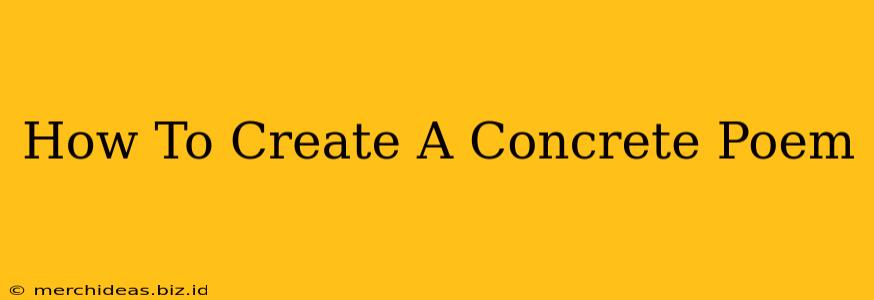Concrete poetry, also known as shape poetry, is a visually stunning form of artistic expression. It goes beyond the traditional linear structure of poems, using typography and spatial arrangement to convey meaning and enhance the reader's experience. Want to learn how to craft your own captivating concrete poem? This guide will walk you through the process, step-by-step.
Understanding the Essence of Concrete Poetry
Before diving into the creation process, it's essential to grasp the core principles of concrete poetry:
- Visual Impact: The poem's shape and arrangement are as crucial as its words. The visual form directly relates to and reinforces the poem's theme or subject matter.
- Word Choice: While the visual aspect is paramount, the words themselves must still hold poetic merit. Choose words carefully to evoke emotion and imagery.
- Theme and Subject: Consider a subject that lends itself well to visual representation. Abstract concepts can be challenging but not impossible!
Step-by-Step Guide to Creating Your Concrete Poem
1. Choosing Your Theme and Subject:
Start by brainstorming. What ideas or concepts resonate with you? Consider subjects that can be easily visualized in a non-linear way. Examples include:
- Nature: A tree, a flower, a bird in flight.
- Objects: A house, a car, a musical instrument.
- Abstract Concepts: Happiness, sadness, love, freedom.
2. Sketching Your Design:
Before writing any words, sketch out the basic shape of your poem on paper. This is crucial for planning the visual impact. Don't worry about perfection; this is a brainstorming exercise. Experiment with different shapes and arrangements until you find one that resonates with your theme.
3. Word Selection and Placement:
Carefully choose words that not only fit the theme but also fit within the shape you've designed. You might need to adjust the shape slightly as you incorporate words. Consider:
- Keywords: Select strong, evocative words that capture the essence of your theme.
- Word Length: Shorter words are often easier to incorporate into complex shapes.
- Font and Size: Experiment with different fonts and sizes to enhance the visual impact.
4. Refining and Revising:
Once you have a draft, review your poem carefully. Ask yourself:
- Does the shape effectively reflect the theme?
- Are the words strong and evocative?
- Is the poem easy to read and understand?
Make necessary adjustments to improve both the visual and textual aspects of your poem.
5. Finalizing and Presenting Your Work:
Once you're satisfied with your concrete poem, consider how you want to present it. You can:
- Handwrite it: This allows for creative use of different fonts and sizes.
- Use a word processor: Programs like Microsoft Word or Google Docs offer formatting options for creating unique shapes.
- Use graphic design software: Programs like Adobe Illustrator or Photoshop offer more advanced typography control for intricate designs.
Examples of Concrete Poetry Themes:
- A Tree: Use lines of varying lengths to create the branches, leaves, and trunk.
- A Bird in Flight: Create a swooping shape with words that describe flight and freedom.
- A Heart: Shape your poem into a heart, using words that express love and affection.
- A Spiral Staircase: Use a spiral shape to create a sense of upward movement or progress.
Unlock Your Creativity: Tips for Success
- Embrace experimentation: Don't be afraid to try different approaches and shapes.
- Start simple: Begin with a less complex shape before tackling intricate designs.
- Seek inspiration: Look at examples of concrete poetry to get ideas and inspiration.
- Have fun! Concrete poetry is a unique and rewarding form of artistic expression. Enjoy the process of creating something visually stunning and creatively satisfying.
By following these steps and utilizing your creativity, you can craft concrete poems that are both visually engaging and poetically resonant. So, grab your pen and paper (or open your word processor), and let your imagination run wild!
